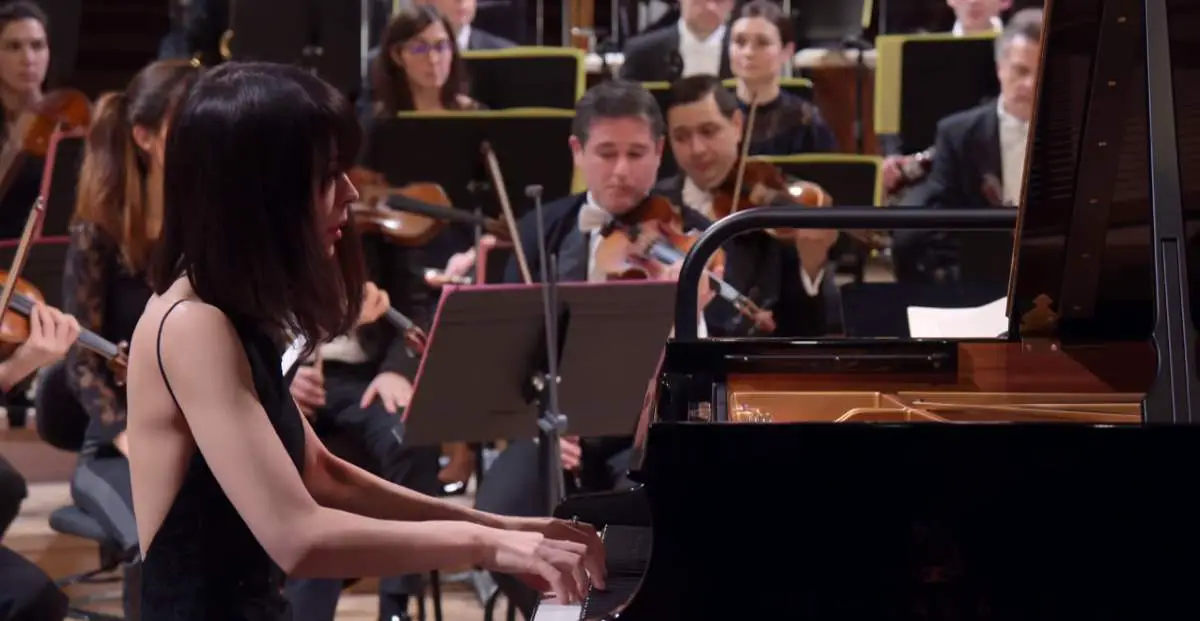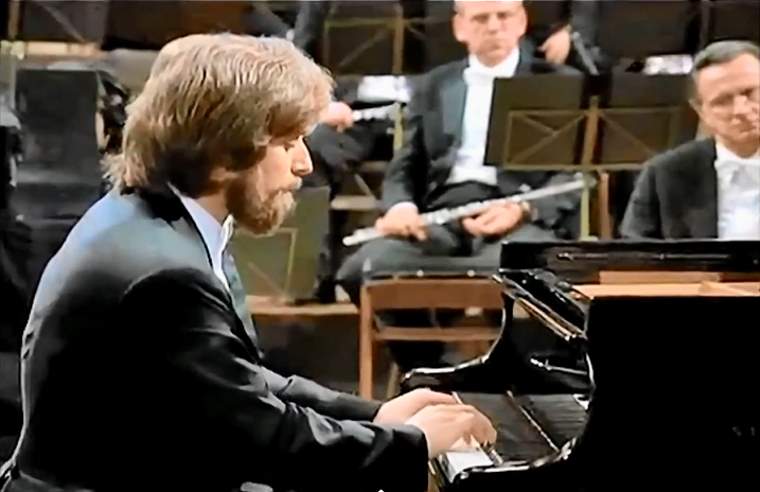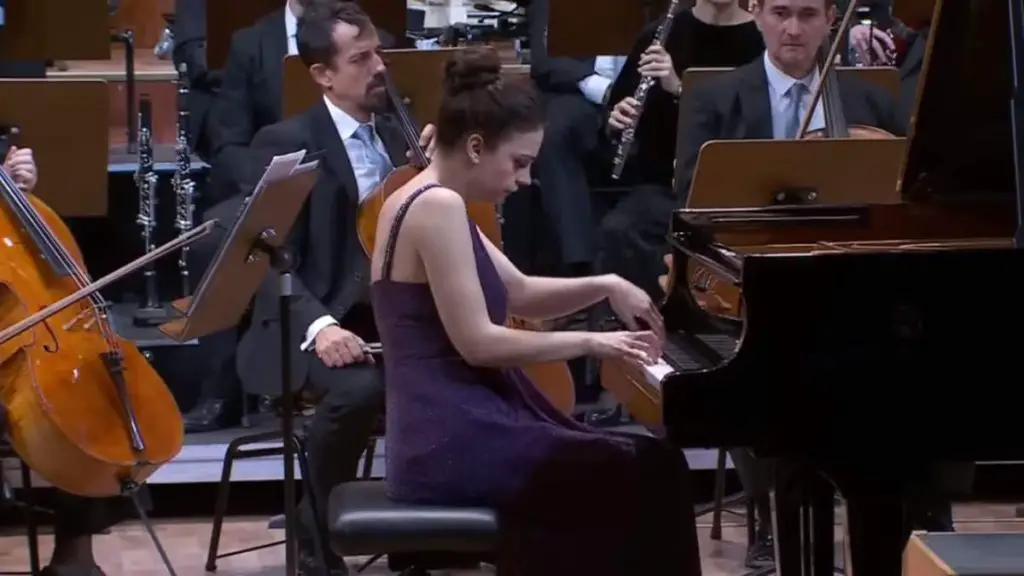Accompanied by the hr-Sinfonieorchester (Frankfurt Radio Symphony Orchestra), Turkish pianist Fazıl Say plays Ludwig van Beethoven’s Piano Concerto No. 3 in C minor, Op. 37. Conductor: Gianandrea Noseda. Alte Oper Frankfurt, March 1, 2013. Cadenza written by Fazıl Say. Encore: Black Earth (36:54) is also written by the pianist himself. It is inspired by Kara Toprak (literally means the black earth), a song by Aşık Veysel (October 25, 1894 – March 21, 1973), a Turkish minstrel and highly regarded poet of Turkish folk literature.
Beethoven’s Piano Concerto No. 3
Beethoven composed his Piano Concerto No. 3 in 1799-1800 and introduced it in Vienna on April 5, 1803. The first sketches go back to 1797 after he had composed the B flat Piano Concerto (published as No. 2), but before the composition of the C major Concerto (in 1798, published as No. 1).
Although Beethoven played the first performance of No. 3 in 1803 from a short score – no one was going to steal it from him! – he’d actually completed the music prior to April 1800, apart from a few last-minute adjustments. In other words, before he wrote the Second Symphony (Op. 36), the Moonlight Piano Sonata (Op. 27/2), or the Op. 31 triptych for keyboard.
The C minor key, often associated with powerful and turbulent emotions, provides a fitting backdrop for the concerto’s themes of struggle and triumph. Unlike his earlier concertos, which adhered more closely to classical conventions, the third concerto embodies a greater sense of individuality and expressiveness. The piano part is notably virtuosic, featuring intricate passages that demand technical prowess and emotional interpretation from the performer. This concerto not only highlights the piano as a solo instrument but also allows for a rich dialogue between the piano and orchestra.
The orchestration of the concerto is noteworthy, employing a full orchestra that includes strings, woodwinds, and brass, which enriches the overall texture and enhances the dramatic contrasts throughout the work. Beethoven’s innovative use of harmony and rhythm, combined with the emotive power of the piano, creates a compelling narrative that captivates audiences.
Beethoven’s Piano Concerto No. 3 has continued to resonate with performers and audiences alike, frequently appearing in concert programs and recordings. It serves as a testament to Beethoven’s genius and his ability to convey profound emotions through music, paving the way for future generations of composers.
Movements
As is standard for Classical/Romantic-era concertos, Beethoven’s Piano Concerto No. 3 is in three movements:
1. Allegro con brio
The first movement of Beethoven’s Piano Concerto No. 3, marked Allegro con brio, is a striking display of thematic development and orchestral interplay that sets a dramatic tone for the entire work. The movement opens with the orchestral exposition, where the main theme is introduced by the strings. This theme serves as a foundation, recurring forcefully throughout the movement in various forms, highlighting Beethoven’s mastery in transforming and developing musical ideas.
In the orchestral exposition, the theme is elaborated multiple times, creating a sense of cohesion and momentum. The second subject emerges in the third section, introduced by the clarinet and first violin, transitioning to the relative major key of E-flat major. This contrast provides a refreshing emotional shift before the piano enters, marking the second exposition. The piano begins with an ascending scale motif, echoing the thematic material established by the orchestra and presenting it in a new light.
The development section sees the piano revisiting the scales introduced in the second exposition, this time in D major. The music remains generally quiet, allowing for introspection amidst the complexity of the textures. As the recapitulation unfolds, the orchestra reinstates the theme with a forceful fortissimo, while the wind instruments contribute to the rich harmonic fabric. Beethoven cleverly modulates to the tonic major, C major, before transitioning to the darker C minor, leading into the cadenza.
Beethoven’s cadenza for this movement is notable for its stormy character, concluding with a series of trills that resolve into a soft pianissimo. This contrasts with the expected return to the tonic, as Beethoven prolongs the final trill before arriving at a dominant seventh. The movement culminates in a series of descending arpeggios from the piano, followed by the resolution in C minor, showcasing Beethoven’s inventive spirit and setting a dramatic tone for the concerto.
2. Largo
The second movement of Beethoven’s Piano Concerto No. 3, marked “Largo,” serves as a striking contrast to the lively energy of the first movement. In this section, the piano emerges as the central voice, delivering deeply introspective and melancholic melodies that resonate with the listener. Beethoven’s masterful use of simple yet poignant musical lines allows him to convey profound emotions, illustrating his ability to evoke a wide range of feelings with elegance and restraint.
The Largo unfolds with a sense of calm and contemplation, providing a moment of reprieve amidst the dynamic energy of the surrounding movements. Its lyrical character invites listeners to reflect on the music’s emotional depth, showcasing Beethoven’s versatility as a composer. The rich harmonies and the piano’s expressive phrasing create an atmosphere of intimacy, allowing the audience to connect with the music on a personal level.
In this movement, Beethoven not only demonstrates his skill in melody but also his understanding of the power of silence and space within music. The subtle nuances in dynamics and articulation enhance the introspective quality, making the Largo a poignant experience. The contrasting textures between the piano and orchestral accompaniment further emphasize the soloist’s emotional journey.
As the movement progresses, it becomes evident that Beethoven’s emotional range extends beyond the exuberance of the first movement. The Largo stands as a testament to his ability to craft moments of vulnerability and beauty within his compositions. This movement is not just a reflection of the pianist’s technical prowess but a deep exploration of the human experience through music.
3. Rondo: Allegro
The final movement of Beethoven’s Piano Concerto No. 3, marked Rondo: Allegro, serves as a triumphant conclusion to this remarkable work. Characterized by its lively and playful themes, this movement showcases a spirited dialogue between the piano and the orchestra. Beethoven’s exceptional skill in crafting infectious melodies is evident throughout, creating an atmosphere of joy and exuberance.
As the Rondo unfolds, Beethoven introduces exciting variations of the main theme, each iteration adding new layers of complexity and charm. This playful treatment of the theme builds anticipation, drawing the audience into the music’s infectious energy. The back-and-forth exchanges between the piano and orchestra contribute to the overall excitement, as the soloist engages in a lively conversation with the ensemble.
The culmination of the movement leads to a brilliant finale, leaving the audience with a profound sense of exhilaration and awe. Beethoven’s ability to weave intricate melodic lines and dynamic contrasts captures the spirit of celebration, marking this movement as one of the most exhilarating passages in the concerto repertoire.
Rondo: Allegro exemplifies Beethoven’s compositional prowess, balancing the classical forms of the era with his innovative spirit. This movement, like the concerto as a whole, is both timeless and emotionally charged, resonating with listeners across generations.
Sources
- Piano Concerto No. 3 (Beethoven) on Wikipedia
- Beethoven: Piano Concerto No. 3 in C minor on ClassicFM.com
- Piano Concerto No. 3, Op. 37 (Beethoven, Ludwig van) on the International Music Score Library Project website
- “Exploring Beethoven’s Piano Concerto No. 3: A Masterpiece of Passion and Innovation” on the LV Beethoven website
- “Piano Concerto No. 3, Ludwig van Beethoven” on the LA Phil website


